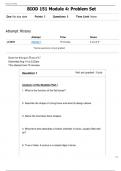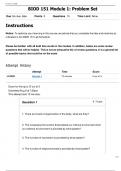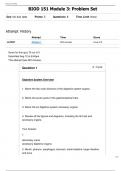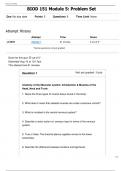Biod 151 problem set - Study guides, Class notes & Summaries
Looking for the best study guides, study notes and summaries about Biod 151 problem set? On this page you'll find 101 study documents about Biod 151 problem set.
Page 4 out of 101 results
Sort by
BIOD 151 Module 4: Problem Set
BIOD 151 Module 1: Problem Set
BIOD 151 Module 3: Problem Set
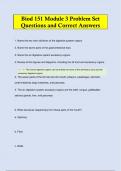
-
Biod 151 Module 3 Problem Set Questions and Correct Answers
- Exam (elaborations) • 13 pages • 2024
-
- $10.49
- + learn more
57. How is the energy released from the breakdown of glucose used by the body? ~ The energy is released during the breakdown of glucose is used by the body to add a phosphate to an adenosine diphosphate molecule and make adenosine triphosphate 58. Describe cellular respiration. ~ During cellular respiration glucose combines with oxygen to form carbon dioxide, water, and ATP 59. Describe glycolysis. ~ In glycolysis glucose is broken down into two pyruvic acid molecules and two ATP mole...
BIOD 151 Module 5: Problem Set
BIOD 151- Module 5 Problem Set Questions and Correct Answers Graded A+
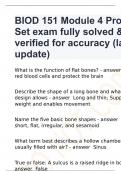
-
BIOD 151 Module 4 Problem Set exam fully solved & verified for accuracy (latest update)
- Exam (elaborations) • 9 pages • 2024
-
Available in package deal
-
- $14.49
- + learn more
What is the function of flat bones? Produce red blood cells and protect the brain Describe the shape of a long bone and what its design allows Long and thin; Supports body weight and enables movement Name the five basic bone shapes Long, short, flat, irregular, and sesamoid What term best describes a hollow chamber in bone, usually filled with air? Sinus True or false: A sulcus is a raised ridge in bone False What division of the skeleton lies along the mi...
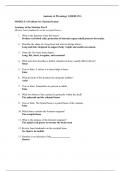
-
Anatomy and Physiology I Module 4 Problem Set (Portage learning)
- Exam (elaborations) • 9 pages • 2023
-
- $18.49
- + learn more
Anatomy & Physiology I (BIOD 151) MODULE 4 Problem Set: Skeletal System Anatomy of the Skeleton Part I (Review bone landmarks on the occipital bone.) 1. What is the function of the flat bones? Produce red blood cells; protection of internal organs (skull protects the brain). 2. Describe the shape of a long bone and what its design allows. Long and thin; designed to support body weight and enable movement. 3. Name the five basic bone shapes. Long, flat, short, irregular, and sesamoid 4....
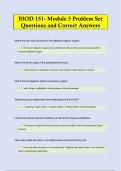
-
BIOD 151- Module 3 Problem Set Questions and Correct AnswersBIOD 151- Module 3 Problem Set Questions and Correct Answers
- Exam (elaborations) • 12 pages • 2024
-
- $10.49
- + learn more
How does the energy formed in fat catabolism compare to that formed in carbohydrate metabolism? ~ Lipid metabolism yields twice the energy formed during glucose metabolism. Name, tell the location of and explain in detail the first stage of lipid breakdown. ~ Lipid metabolism occurs in the liver by a process known as beta-oxidation to form acetic acid which is further catabolized by the TCA cycle to carbon dioxide forming some ATP. Why are proteins not usually used as a body energy sourc...
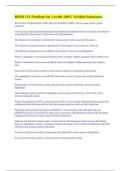
-
BIOD 151 (ALL ACCURATELY SOLVED)
- Package deal • 7 items • 2023
-
- $38.48
- + learn more
BIOD 151 Module 1 (100% Correct Answers) Portage Learning- BIOD 151 Exam 1 (100% Verified Solutions) BIOD 151 Module 1 Study Set (A+ Graded) BIOD 151 Module 2 (100% Accurate) BIOD 151 Module 6 Exam (100% Error-free Answers) BIOD 151 EXAM 1 (ALL ACCURATELY SOLVED) BIOD 151 Problem Set 1 (with 100% Verified Solutions)

That summary you just bought made someone very happy. Also get paid weekly? Sell your study resources on Stuvia! Discover all about earning on Stuvia

